Futures
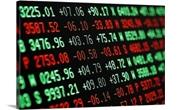
Hot Rolled Steel Futures: The Big Ripper
February 24, 2022
Editor’s note: SMU contributor Bryan Tice is a partner at Metal Edge Partners, a firm engaged in Risk Management and Strategic Advisory. In this role, he and the firm design and execute risk management strategies for clients along with providing process and analytical support. Before joining Metal Edge Partners, Bryan held a variety of commercial leadership roles involving purchasing, sales, and risk management for Feralloy Corporation, Cargill Steel Service Centers and Plateplus Inc. You can learn more about Metal Edge at www.metaledgepartners.com. Bryan can be reached at Bryan@metaledgepartners.com.
Exactly three weeks ago today, I wrote the HRC futures article entitled, “Opposing Forces” on day one of Russia’s invasion of Ukraine. Metal Edge Partners was fortunate to have been briefed by our Washington, D.C., contacts well in advance of the invasion of the potential risks of Russian aggression on the world order. Unfortunately, the devastation in Ukraine and the impact on the Ukrainian people over these long three weeks has exceeded most of our expectations. But their bravery and resolve have provided inspiration to the rest of the freedom-loving world.
Most of us have never witnessed a geopolitical event of this magnitude in our lifetime and with that comes blind spots. Amid an epic collapse in U.S. steel prices that was still unfolding into late February/early March following an unprecedented price rally that began in September 2020, few would have predicted a reversal of this pace and magnitude.
The following charts are the typical comparisons of the month-over-month changes in the HRC and Busheling scrap futures forward curve, but these charts are in no way normal. In fact, they look more like star constellations than a normal futures curve.
HRC Futures – The Big Ripper
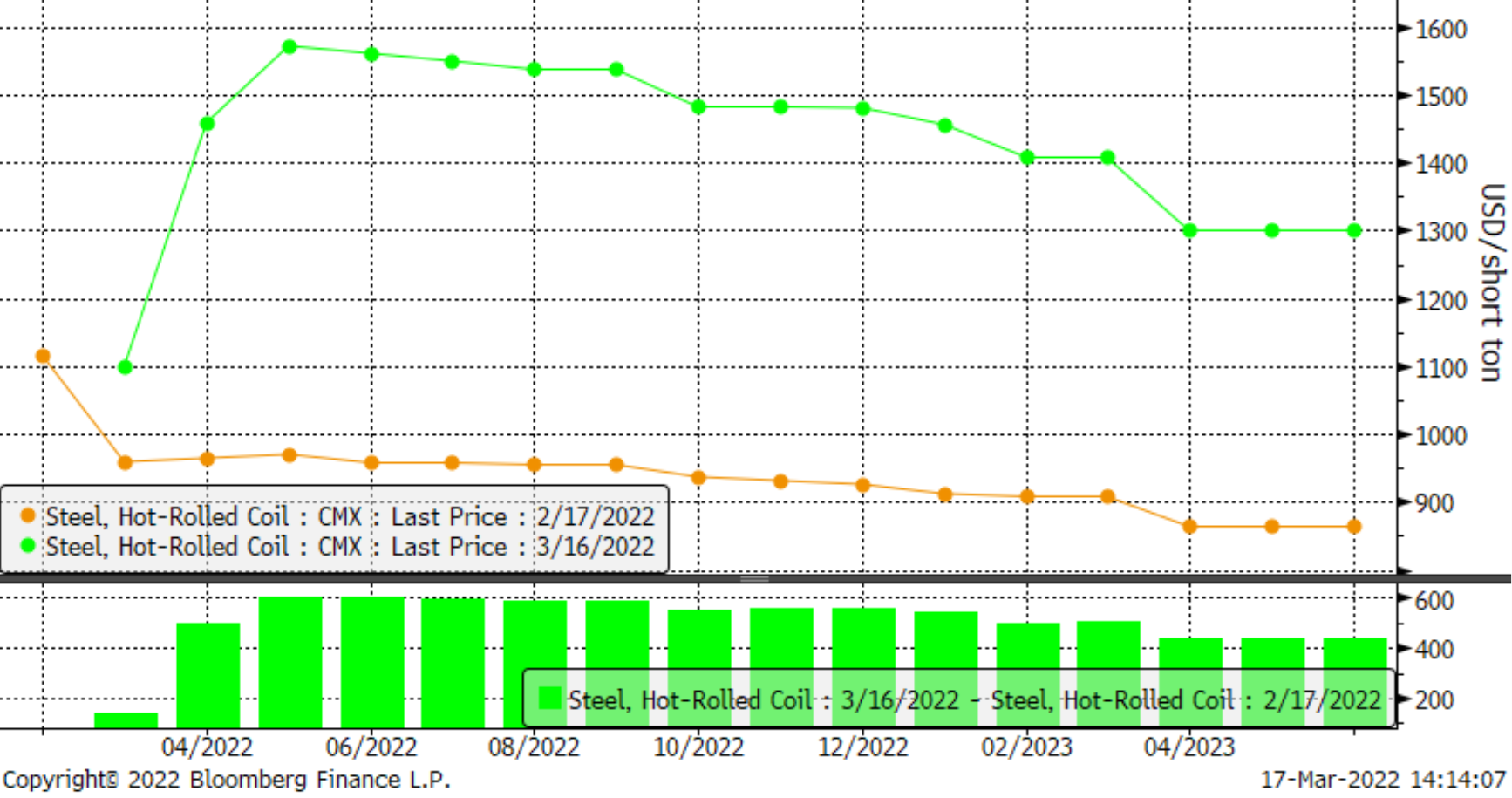
Busheling Scrap Futures – The Little Ripper
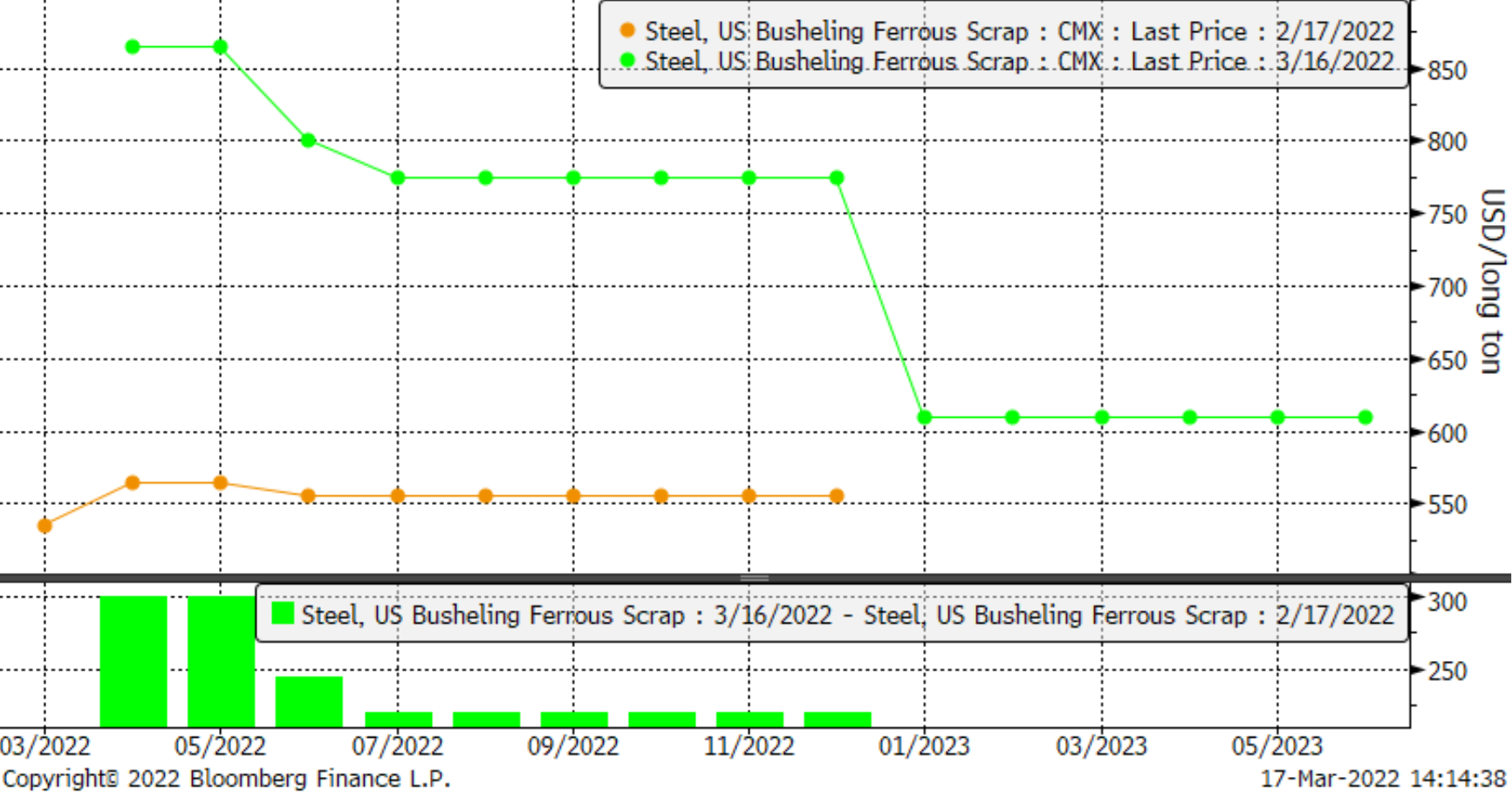
Considering the massive price rally on HRC/scrap futures, suddenly the plate to HRC spreads no longer seem as egregious as recent plate price increases have not kept pace with HRC/scrap increases. Looking at the spread between the HRC forward curve 2nd month futures and physical plate prices, we are seeing a normalization of the spread compared to recent historical levels.
HRC 2 mo. Future vs. Physical Plate
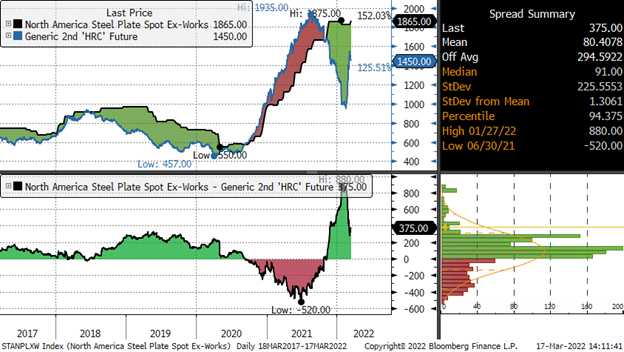
The raw material/input side of the equation is the fundamental driver of where pricing may be headed. Pig iron availability and the subsequent impact on scrap prices seems to be driving the bus as it relates to input costs here in the U.S. and the resultant impact on steel prices, but the unwinding of global supply chains is a complex and an unpredictable beast to forecast. Juxtaposed to the raw material situation is the wildcard that is on everyone’s mind— whether we are destined for an ugly recession and, if so, when will we begin to see demand destruction, and where that event falls on the 2022 calendar. The automotive sector, despite chronically low inventories and strong demand for new vehicles, remains hamstrung by the myriad of supply-chain issues related to semiconductors and other components. Automotive production outlooks seem to be worsened by the outlook of supply-chain disruptions of neon gas, used in chip production, and rare earth materials like palladium, which are used in semiconductors and catalytic converters, where Ukraine is an important supplier. Further, there is even a pullback in tire production in Russia. It does not appear that strong automotive sector demand will be a factor contributing to this current up-cycle. Whether U.S. consumers can shrug off high gas and food prices remains to be seen, but for now most in the physical steel business (sans automotive) continue to report robust demand.
Across the pond, the frenzied pace around steel continues to play out with ArcelorMittal leading the latest round of price increases yesterday, raising HRC prices to €1,400, CRC to €1500 and HDG to €1550. The chart below shows an equally impressive month-over-month gain in European HRC futures prices.
European HRC Futures Prices
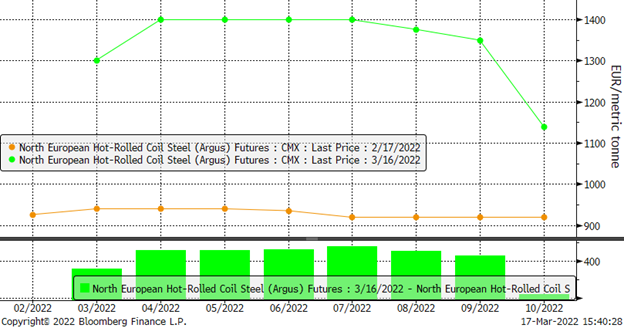
We continue to hear chatter in the marketplace of U.S. mills mulling over the opportunity to export tons to Europe and beyond, which would help absorb some of the new flat rolling capacity coming online currently and over the next few quarters should that happen. Regardless of whether we can look to the heavens for answers of how the steel market plays out over the next quarter or two, what is abundantly clear is that several non-fundamentals are driving the current market environment and it is worthwhile to have a risk management strategy in place to navigate these turbulent times.
In the meanwhile, on this St. Patrick’s Day, I will leave you with the following Irish toast…. “May you have warm words on a cold evening, a full moon on a dark night, and the road downhill all the way to your door.” Slainte!
Disclaimer: The information in this write-up does not constitute “investment service,” “investment advice,” or “financial product advice” as defined by laws and/or regulations in any jurisdiction. Neither does it constitute nor should be considered as any form of financial opinion or recommendation. The views expressed in the above article by Metal Edge Partners are subject to change based on market and other conditions. The information given above must be independently verified and Metal Edge Partners does not assume responsibility for the accuracy of the information.
Latest in Futures

HR Futures: Summertime blues
Coming out of the holiday market and long weekend, it seems the HRC futures market has caught some post-vacation blues.

HR Futures: Financial players bullish on price, physical market participants not
We can interpret that managed money still has expectations of price strength while physical participants are running closer to a balance on a net basis.

HR Futures: Oil, Mideast tensions fail to move steel
After a hot start to June, the CME ferrous derivatives complex has cooled down.

HRC Futures: Could oil, ag price spikes drive steel higher too?
Could we see an abrupt shift now that oil prices have spiked higher? Will we see a rebound in the rig count? Will this create a snap-loading effect (think waterski rope), where the industry suddenly does a 180-degree turn? If so, will that bring with it increased demand for steel products used by the energy industry?

Flack: HR futures still on a wild ride
Never a dull moment in today's HR futures market.
